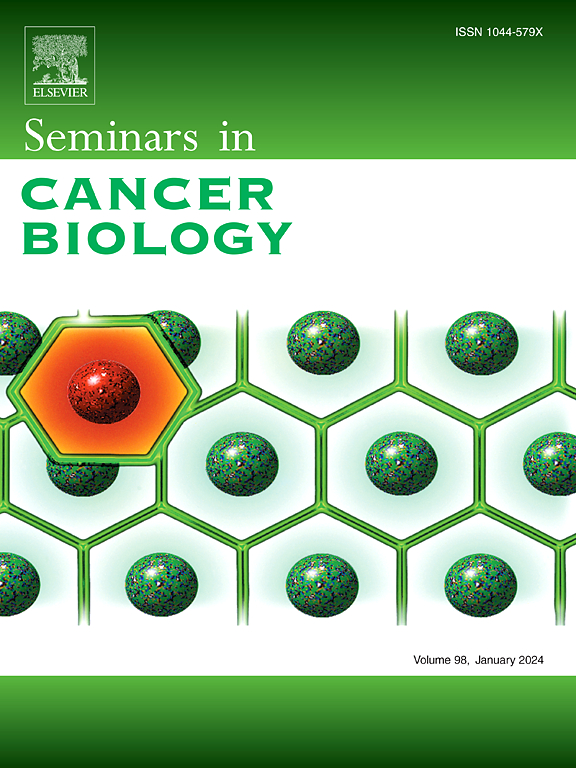上皮-间质转化促进代谢重编程抑制铁下垂。
IF 12.1
1区 医学
Q1 ONCOLOGY
引用次数: 0
摘要
上皮间充质转化(Epithelial-mesenchymal transition, EMT)是一个细胞去分化的过程,它为细胞提供了胚胎发育、组织重塑、伤口愈合和转移所需的可塑性和干细胞样特征。形态学上,EMT使肿瘤细胞具有成纤维细胞样特性,通过在其磷脂膜中加入高水平的多不饱和脂肪酸(PUFA),导致细胞骨架重排(刚度丧失)和膜刚度降低。尽管膜中大量的PUFA降低了刚性,并为肿瘤细胞在转移过程中提供了无限制的拉伸、弯曲和扭曲的能力,但这些PUFA极易受到脂质过氧化的影响,从而导致膜完整性的破坏,最终导致铁下垂。为了避免铁下垂风险,EMT还触发代谢程序的重新布线,特别是在脂质代谢中,以加强EMT的表观遗传调控,减轻铁下垂的潜在损害。因此,EMT、脂质代谢和铁下垂之间的相互作用突出了癌症生物学和转移中复杂调控的新层面。在这里,我们总结了最新的发现,并讨论了这些相互作用。最后,我们提供了这些相互作用如何促进转移性肿瘤细胞的细胞可塑性和铁下垂抵抗的观点,可以探索创新的治疗干预措施。本文章由计算机程序翻译,如有差异,请以英文原文为准。
Epithelial-mesenchymal transition promotes metabolic reprogramming to suppress ferroptosis
Epithelial-mesenchymal transition (EMT) is a cellular de-differentiation process that provides cells with the increased plasticity and stem cell-like traits required during embryonic development, tissue remodeling, wound healing and metastasis. Morphologically, EMT confers tumor cells with fibroblast-like properties that lead to the rearrangement of cytoskeleton (loss of stiffness) and decrease of membrane rigidity by incorporating high level of poly-unsaturated fatty acids (PUFA) in their phospholipid membrane. Although large amounts of PUFA in membrane reduces rigidity and offers capabilities for tumor cells with the unbridled ability to stretch, bend and twist in metastasis, these PUFA are highly susceptible to lipid peroxidation, which leads to the breakdown of membrane integrity and, ultimately results in ferroptosis. To escape the ferroptotic risk, EMT also triggers the rewiring of metabolic program, particularly in lipid metabolism, to enforce the epigenetic regulation of EMT and mitigate the potential damages from ferroptosis. Thus, the interplay among EMT, lipid metabolism, and ferroptosis highlights a new layer of intricated regulation in cancer biology and metastasis. Here we summarize the latest findings and discuss these mutual interactions. Finally, we provide perspectives of how these interplays contribute to cellular plasticity and ferroptosis resistance in metastatic tumor cells that can be explored for innovative therapeutic interventions.
求助全文
通过发布文献求助,成功后即可免费获取论文全文。
去求助
来源期刊

Seminars in cancer biology
医学-肿瘤学
CiteScore
26.80
自引率
4.10%
发文量
347
审稿时长
15.1 weeks
期刊介绍:
Seminars in Cancer Biology (YSCBI) is a specialized review journal that focuses on the field of molecular oncology. Its primary objective is to keep scientists up-to-date with the latest developments in this field.
The journal adopts a thematic approach, dedicating each issue to an important topic of interest to cancer biologists. These topics cover a range of research areas, including the underlying genetic and molecular causes of cellular transformation and cancer, as well as the molecular basis of potential therapies.
To ensure the highest quality and expertise, every issue is supervised by a guest editor or editors who are internationally recognized experts in the respective field. Each issue features approximately eight to twelve authoritative invited reviews that cover various aspects of the chosen subject area.
The ultimate goal of each issue of YSCBI is to offer a cohesive, easily comprehensible, and engaging overview of the selected topic. The journal strives to provide scientists with a coordinated and lively examination of the latest developments in the field of molecular oncology.
 求助内容:
求助内容: 应助结果提醒方式:
应助结果提醒方式:


